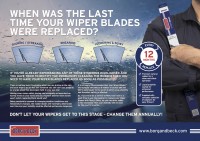Automotive aftermarket forays into e-commerce to boost sales
 The rising number of do-it-yourself (DIY) customers, who assemble spare parts themselves is said to be significantly bolstering the e-commerce automotive aftermarket
The rising number of do-it-yourself (DIY) customers, who assemble spare parts themselves is said to be significantly bolstering the e-commerce automotive aftermarket
The global e-commerce automotive aftermarket is largely consolidated with the presence of a few key companies that hold majority of the market share, according to report published in January by Transparency Market Research. This being the case, the automotive aftermarket’s forays into e-commerce are expected to boost sales in the years to come.
Transparency’s data suggests the global e-commerce automotive aftermarket is likely to register 18.5 per cent compound annual growth rate for the period between 2017 and 2025. Expanding at this pace, the market will be valued at US$137 billion revenue by 2025.
Brake pads and related products are the most frequently replaced. The segment is likely to display the leading CAGR over the forecast period between 2017 and 2025. Among the key channels, third party standalone e-tailer segment held the leading share in 2016 thus accounting for the leading revenue contribution. This growth is mainly because of collaborations between e-commerce platform providers and service providers. Powered by economic growth in emerging countries, Asia Pacific currently dominates the global e-commerce automotive aftermarket.
Availability of multiple brands a key consumer driver
The increasing number of e-commerce platforms and rising collaboration between e-commerce platform providers and brick & mortar stores is one of the prominent factors driving the e-commerce automotive aftermarket over the report’s forecast period.
E-commerce automotive aftermarket is an online platform for selling auto parts to do-it-yourself customers and service professionals. The aftermarket covers all automotive spare parts, accessories, equipment, and services to automobiles that are either new or are procured from used vehicles and are available for sale.
Another prominent factor growth driver of the e-commerce automotive aftermarket is e-tailers acting as service aggregators to provide price and quality assurance to customers. E-commerce platforms are increasingly being opted by customers due to the availability of multiple brands at competitive prices, and also because the platform serves product specifications and varied product requirement of customers. Owing to this, service aggregator e-commerce platforms is likely to stoke the growth of e-commerce automotive aftermarket.
The rising number of do-it-yourself (DIY) customers, who assemble spare parts themselves is significantly bolstering the e-commerce automotive aftermarket. DIY customers mostly opt for products without installation services, which makes the online platform preferable among them.
The entry of aftermarket manufacturers into e-tailing is another prominent factor driving the e-commerce automotive aftermarket. These B2C sales channels are eliminating the need of middlemen and cost benefits are thus passed on to customers. This is serving to boost sales further.
Some of the key participants in the global e-commerce automotive aftermarket include Advance Auto Parts, Amazon Inc., National Automotive Parts Association, Pep Boys, EBay Inc., Cdiscount, ERA SPA, AliExpress, O’Reilly Automotive Inc., Shopee365, Alibaba Group, AutoZone Inc., DENSO Corporation, U.S. Auto Parts Network Inc., Rakuten Commerce LLC, Das Ersatzteil GmbH, CATI SpA, DNABER Auto Parts, Q-Parts 24, and LKQ Corporation.



Comments